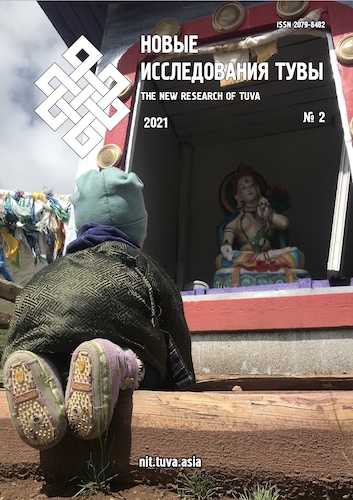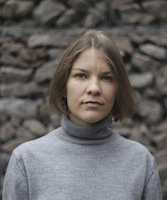Buddhist Icon from the Natural Landmark of Kyzyl-Tei
DOI:
https://doi.org/10.25178/nit.2021.2.3Keywords:
Buddhist icon; thangka; Kunstkamera; Tuva; Kyzyl-TeiAbstract
The purpose of this article is to introduce information on the Buddhist icon discovered by A.D. Grach in the south-eastern part of the rock mass of Kyzyl-Tei (Tuva) in 1953 into academic circulation. The relic itself is now kept in the Peter the Great Museum of Anthropology and Ethnography (the Kunstkamera) of the Russian Academy of Sciences. The field records of the archaeologist were lost, but we managed to reconstruct the history of the icon’s discovery from other sources — archival materials and museum documentation of the Kunstkamera.
It is noted that the finding is related to one of the stories of the saving of the Buddhist relics by individual believers during the period when religion and religious acolytes were suffering reprisals in the region in the 1930s. A.D. Grach learned about the cache from a Tuvan informant and took the discovered icon to Leningrad (St. Petersburg).
It has been found out that the Buddhist icon depicts the White Tara in the “vajra pose”. The icon was painted on a primed canvas. The image on the canvas is outlined with a red border. The canvas is placed in a wooden frame with glass front. On the inside of the frame, there are three lines of a prayer in Mongolian, which are transliterated and translated.
References
Bicheldei, U. P. (2019) Samyi bol'shoi applikatsionnyi buddiiskii svitok iz fondov Natsional'nogo muzeia Tuvy [The
largest appliqué Buddhist scroll in the collections of the National Museum of the Republic of Tuva]. New Research of Tuva,
no. 2, pp. 161–169. (In Russ.). DOI: https://doi.org/10.25178/nit.2019.2.14
Grach, A. D. (1957) Petroglify Tuvy, I. (Problema datirovki i interpretatsii, etnograficheskie traditsii) [Petroglyphs of
Tuva, I. (The problem of dating and interpretation, ethnographic traditions)]. In: Sbornik Muzeia antropologii i etnografii
[Collection of the Museum of Anthropology and Ethnography]. Moscow ; Leninrgad, Publ. House of the Academy of Sciences of the USSR. Vol. XVII. 541 p. Pp. 385–428. (In Russ.).
Grach, A. D. (2020) Avtobiografiia A. D. Gracha [Autobiography of A. D. Grach]. In: Arkheologicheskie vesti [Archaeological
News]. Issue 26. St. Petersburg, Institute for the History of Material Culture RAS. 304 p. P. 57. (In Russ.).
D'iakonova, V. P. (2005) Sibirskie ekspeditsii L. P. Potapova [Siberian expeditions of L. P. Potapov]. In: Muzei v XXI veke:
problemy i perspektivy [Museum in the 21st century: Problems and prospects] : Proceedings of the International science-topractice conference : in 2 parts / ed. by K. A. Bicheldei. Kyzyl, Printing House of the Kyzyl Educational Center “Anyiak”. Part II. 156 p. Pp. 53–61. (In Russ.).
Istoriia Tuvy [The History of Tuva] (2007) : in 3 vols. / ed. by V. A. Lamin. Novosibirsk, Nauka. Vol. 2. 430 p. (In Russ.).
Kisel', V. A. (2011) Zabytyi issledovatel' Tuvy [A forgotten researcher of Tuva]. In: Prokof'eva, E. D. Protsess natsional'noi
konsolidatsii tuvintsev [The process of national consolidation of the Tuvans]. St. Petersburg, Nauka. 538 p. Pp. 13–27. (In Russ.)
Mongush, M. V. (2001) Istoriia buddizma v Tuve (vtoraia polovina VI — konets XX v.) [The history of Buddhism in Tuva
(Latter half of the 6th — late 20th cc.)]. Novosibirsk, Nauka. 200 p. (In Russ.).
Otroshchenko, I. V. (2016) Sangkha v kontekste gosudarstvennoi politiki Tuvinskoi Narodnoi Respubliki [The sangha
and the politics of People’s Republic of Tuva]. New Research of Tuva, no. 3, pp. 34–53. (In Russ.).
Terent'ev, A. A. (2004) Opredelitel' buddiiskikh izobrazhenii [Identifier of Buddhist images]. St. Petersburg, Nartang. 304 p.
(In Russ.).
Safronova, E. S. (1999) Buddizm v stranakh Zapada i v Rossii (istoriko-kul'turnyi analiz) [Buddhism in the countries of the
West and in Russia (Historical and cultural analysis)] : Diss. ... Doctor of History. Moscow. 493 p. (In Russ.).
Sumba, R. P. (2019) Pis'mennye istochniki na tibetskom iazyke iz fondov Natsional'nogo muzeia Tuvy [Written sources
in Tibetan language in the collections of the National Museum of the Republic of Tuva]. New Research of Tuva, no. 2,
pp. 128–138. (In Russ.). DOI: https://doi.org/10.25178/nit.2019.2.11
Khomich, L. V. (2004) Ekaterina Dmitrievna Prokof'eva — issledovatel' traditsionnoi kul'tury sel'kupov [Ekaterina
Dmitrievna Prokofieva — a researcher of the traditional culture of the Selkups]. In: Kur'er Petrovskoi Kunstkamery [Courier
of the Petrovskaya Kunstkamera] / editor-in-chief A. S. Myl'nikov. St. Petersburg, Museum of Anthropology and Ethnography RAS. Vol. 10–11. 218 p. Pp. 44–51. (In Russ.).
Khomushku, O. M. (1991) Evoliutsiia i sovremennoe sostoianie religioznosti v Tuve [Evolution and the current state
of religiosity in Tuva] : Abstract of the Diss. … Candidate of Philosophy. Moscow. 24 p. (In Russ.).
Khomushku, O. M. (2006) Religioznyi sinkretizm u narodov Saiano-Altaia [Religious syncretism among the peoples of Sayan-Altai]: Diss. … Doctor of Philosophy. Moscow. 299 р. (In Russ.).
Published
How to Cite
https://www.doi.org/10.25178/nit.2021.2.3
For citation:
Stanulevich N. A. Buddiiskaia ikona iz urochishcha Kyzyl-Tei [Buddhist Icon from the Natural Landmark of Kyzyl-Tei].
New Research of Tuva, 2021, no. 2, pp. 35-43. (In Russ.). DOI: https://www.doi.org/10.25178/nit.2021.2.3
Issue
Section
Copyright (c) 2021 Журнал "Новые исследования Тувы" (составление)

This work is licensed under a Creative Commons Attribution-NonCommercial 4.0 International License.

Author(s) license holder(s) grant rights for their work to the journal (grantee of a license) under the simple non-exclusive open license in accordance with Art. 1286.1 «Open license for a research work, work of literature or fine arts», Civil Code of the Russian Federation.
New Research of Tuva publishes articles under the Creative Commons Attribution-NonCommercial license (CC BY-NC).
Since it is an open license, author(s) reserve the right to upload the article to their institutional repository, submit it to another journal (if it allows republications), or republish it on their own website (in full, or in part).
However, several conditions apply here:
a) The republished version must always contain the name(s) and affiliation(s) of the author(s), the original title and the hyperlink to the original version on the New Research of Tuva website;
b) It must be in open access, free of charge, and no category of readers must be in any way whatsoever advantaged over general readership.
c) should the contribution be submitted elsewhere by its author(s) without substantial modification (30% or more of original text unchanged), the body of the article should contain a disclaimer that the original version was published in New Research of Tuva (with a link to the respective page)
The CC-BY-NC is a non-revocable license which applies worldwide and lasts for the duration of the work’s copyright.









